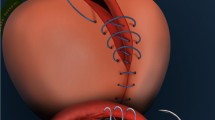Abstract
Introduction and hypothesis
The aim of this paper is to review proposed classifications for genito-urinary fistulae.
Methods
A comprehensive literature review of historical texts, peer review publications, and abstracts was used to compile a listing of the existing genito-urinary fistula classification systems.
Results
The absence of an accepted standardized classification for female genito-urinary fistulae has resulted in the proliferation of a number of individually devised categorizations. Fistulae are described by size, location, degree of vaginal scarring, and type (whether it involves the bladder, rectum, intestines, uterus, etc). In addition, most classification systems have not been subjected to outcomes research, making them primarily descriptive in nature.
Conclusions
There is a lack of consensus among fistula surgeons in adopting a standardized classification system or systems. Comparative assessment of studies and outcomes is not possible without a standardized classification system. Currently, there is no accepted standardized classification for female genito-urinary fistula.




Similar content being viewed by others
References
Creanga AA, Genadry RR (2007) Obstetric fistulas: a clinical review. Int J Gynaecol Obstet 99(Suppl 1):S40–S46, Nov
Sims JM (1852) On the treatment of vesico-vaginal fistula. Am J Med Sci 23:59–82
Mahfouz N (1929) Urinary and recto-vaginal fistulae in women. J Obstet Gynaecol Br Emp 36:581–589
Moir JC (1956) Personal experience in the treatment of vesicovaginal fistulas. Am J Obstet Gynecol 71:476–491
Moir JC (1967) The circumferential vesico-vaginal fistula. In: The vesico-vaginal fistula. Bailliere Tindall and Cassell, London, pp 134–144
McConnachie ELF (1958) Fistulae of the urinary tract in the female. SA Med J 32:524–527
Bird GC (1967) Obstetric vesico-vaginal and allied fistulae. J Obstet Gynaecol Br Commonw 74:749–752
Gray PH (1970) Obstetric vesicovaginal fistulas. Am J Obstet Gynecol 107:898–901
Lawson JB (1968) Birth-canal injuries. Proc R Soc Med 61:22–24
Hamlin RH, Nicholson EC (1969) Reconstruction of urethra totally destroyed in labour. BMJ 2:147–150
Gueye SM, Ba M, Sylla C, Diagne BA, Mensah A (1992) Vesicovaginal fistulas. Etiopathogenic and therapeutic aspects in Senegal. J Urol (Paris) 98(3):148–151, French
Elkins TE (1994) Surgery for the obstetric vesicovaginal fistula: a review of 100 operations in 82 patients. Am J Obstet Gynecol 170(4):1108–1118, Apr
Waaldijk K (1995) Surgical classification of obstetric fistula. Int J Gynaecol Obstet 49:161–163
Browning A, Patel TL (2004) FIGO initiative for the prevention and treatment of vaginal fistula. Int J Gynaecol Obstet 86(2):317–322, Aug
Goh JTW (2004) A new classification for female genital tract fistula. ANZJOG 44:502–504
Goh JTW, Browning A, Berhan B, Chang A (2008) Predicting the risk of failure of closure of obstetric fistula and residual urinary incontinence using a classification system. Int Urogynecol J 19(12):1659–1662
Arrowsmith S (2007) The classification of obstetric vesico-vaginal fistulas: an evidence-based approach. Int J Gynaecol Obstet 99:S25–S27
Tafesse B (2008) New classification of female genital fistula. J Obstet Gynaecol Can 30:394–395
Hassim A, Lucas C (1974) Reduction in the incidence of stress incontinence complicating fistula repair. Br J Surg 61:461–465
Bump RC, Mattiasson A, Bø K, Brubaker LP, DeLancey JO, Klarskov P, Shull BL, Smith AR (1996) The standardization of terminology of female pelvic organ prolapse and pelvic floor dysfunction. Am J Obstet Gynecol 175(1):10–17, Jul
Conflicts of interest
None.
Author information
Authors and Affiliations
Corresponding author
Rights and permissions
About this article
Cite this article
Goh, J., Stanford, E.J. & Genadry, R. Classification of female genito-urinary tract fistula: a comprehensive review. Int Urogynecol J 20, 605–610 (2009). https://doi.org/10.1007/s00192-009-0804-2
Received:
Accepted:
Published:
Issue Date:
DOI: https://doi.org/10.1007/s00192-009-0804-2




